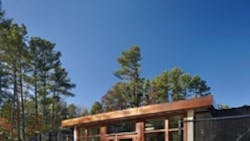School Construction: A Home for Lemurs
Duke University, Durham, N.C., has two new LEED silver-certified facilities at the Duke Lemur Center (DLC), a refuge housing the world’s largest collection of lemurs outside of their native Madagascar. The sanctuary is tasked with non-invasive research and conservation of lemurs.
The $10.4 million school construction project includes the Releasable Building, housing 60 lemurs that free range when weather permits in the DLC’s fenced 69-acre Duke Forest; and a Semi-Releasable Building, housing 80 lemurs that, for age, physical, behavioral or social reasons, have limited free-ranging capacity. Both buildings were designed with research facilitation in mind.
To streamline the time devoted to feeding, caring and cleaning up after the lemurs, the architect designed each building with animal housing wings radiating from a core area that has common resources such as a food-prep kitchen for the keepers to prepare and portion food, a veterinary exam room, a laboratory, a bathroom with shower, and storage spaces for animal-enrichment items and researchers’ equipment. Each wing houses 20 lemurs and dedicated storage for cleaning and keeper supplies.
The Releasable Building has a dry lab for researchers to record observations of the free-ranging lemurs. The Semi-Releasable Building has a wet lab with a fume hood, chemical storage and ventilation to support biological and chemical analysis. Its core also houses two hibernation rooms that are being used to study hibernation in the DLC’s dwarf lemur population.
The architect is Lord, Aeck & Sargent (Chapel Hill, Ga.)
